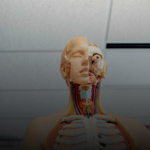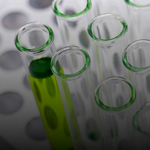Preview this deck
In the cytoplasm , the receptor releases (blank) and the (blank)
Front
Active users
1
All-time users
1
Favorites
0
Last updated
3 years ago
Date created
Feb 3, 2022
Cards (70)
Unsectioned
(70 cards)
In the cytoplasm , the receptor releases (blank) and the (blank)
In the cytoplasm, the receptor releases ran-GDP and the cargo
G-protein coupled receptors is a _____ polypeptide
G-protein coupled receptors is a single polypeptide
CAmp is the second messenger. It is produced using AC levels of camp determined by the enzyme that breaks down. Phosphodiesterase breaks down the camp
CAmp is the second messenger. It is produced using AC levels of camp determined by the enzyme that breaks down. Phosphodiesterase breaks down the camp
What are some medicated biological receptors associated with GPCR
- embryogenesis
- taste
- smell
- vision
- development
What is RTK
RECEPTOR TYROSINE KINASES
What is a NLS and where is it found?
- nuclear localization signal
- found in proteins
- contains many lysine and arginine residues
- proteins. can be transported into the nucleus completely intact
Ran-gtp promotes binding between the (blank ) and (blank)
Ran-GTP promotes binding between the nuclear export receptor and cargo protein
- also influences the receptor +cargo and pore filaments
The binding of the g protein activates the ________
- second messenger
- not a specific reaction
What is paracrine signaling?
- When the target cell is adjacent to the same cell that sent the signal
G SUB ALPHA Q —> PATHWWAY
THIS PROTEIN IIS A STIMULATORY PROTEIN . ACTIVATES A DOWN STREAM ENZYME
- true
In order for a cell to respond to a signal molecule, what must it have?
- It must have a signal receptor
Where do all proteins begin synthesis?
In the cytosolic ribosomes, some proteins end up in other places
- organelles
- cytosol
- outside of the cell
- organelle membrane
- plasma. membrane
Explain the distinct complex of a nuclear pore.
- pore complexes might contain water-filled channels tthat allow small molecule (5k daltons and smaller to diffuse.
- large molecules do not diffuse easily (60 kda and larger )
- the pore might have plug that opens and closes. during transport
what happens if a cell doesn't have a receptor ?
- The signal can not be completed!
Ga(alpha)+GTP= active
____affinity for by and ___ affinity to the enzyme
low affinity for by and high affinity to the enzyme
What are the steps of signal amplification?
ex epinephrine
- epinephrine is released(ligand)
- Goes up the bloodstream.
- Binds to a plasma membrane receptor
What can the several molecular complexes do in the nucleus
- They can move back and forth between the nucleus and the cytoplasm
- histones
- rna
- t-factors
- t-rna ,m-rna
they move via pore complexes
What does GPCR stand for ?
G-protein coupled receptor (GPCR)
CYCLIC AMP AMPLIFIES THE SIGNAL
BIGGEST EFFECTOR OF CAMP IS PROTEIN KINASE A
PRODUCES RISE IN PROTEIN KINASE AND THAT PRODUCES A WHOLE BUNCH OF STUFF IN SIDE OF CELLS
PROTEIN KINASE A IS ACTIVATES WHEN CAMP TO ITS REGULATORY(INHIBITORY) SUBUNIT
CYCLIC AMP AMPLIFIES THE SIGNAL
BIGGEST EFFECTOR OF CAMP IS PROTEIN KINASE A
PRODUCES RISE IN PROTEIN KINASE AND THAT PRODUCES A WHOLE BUNCH OF STUFF IN SIDE OF CELLS
PROTEIN KINASE A IS ACTIVATES WHEN CAMP TO ITS REGULATORY(INHIBITORY) SUBUNIT
The binding of the extracellular domain changes the _________
The binding of the extracellular domain changes the intracellular domain
Signaling molecules can elicit a _____ through _____ or other covalent modification or a slow response through _____
- Signaling molecules can elicit a fast response through phosphorylation or other covalent modification or a slow response through gene expression
- Hours-days( slow response)
ex.Slow example: steroid hormone cortisol acts by activating transcription regulator (ebony)
FAST EFFECTS INVOLVE PRE-EXISTING PROTEINS
IT DOESN'T LAST VERY LONG COMPARED TO SLOW EFFECTS
SLOW AFFECTS GENE TRANSCRIPTION AND THEN TRANSLATION OF A PROTEIN
SLOW EFFECTS ARE LONG-LASTING
what is the function of beta gamma subunits
The nuclear membrane is continuous with
- The RER
WHAT IS TRUE ABOUT G-PROTEIN COUPLED RECEPTORS
THEY CROSS THE PLASMA MEMBRANE 7 TIMES
Why is a second messenger needed?
- Hormones are released in the blood in tiny amounts
- Second messengers amplify or increase the message that the hormone is trying to send
What is Endocrine signaling ?
A signal that travels some distance within the Blood before it meets its target.
G-protein coupled receptors has the ability to zig-zag in the plasma membrane.. true or false
true
Ga(alpha)+GTP=
Ga(alpha)+GTP= active
What are the different types of receptors are there?
- Plasma Membrane-Bound Receptor stuck in the plasma membrane Often hydrophilic (water-soluble/water-loving)
- Intracellular receptor- in the cytoplasm or in the nucleus
The nucleus is separated from the cytoplasm by two membranes. This nuclear membrane consists of a water-impermeable phospholipid bilayer and various associated proteins. What is the name for this nuclear envelope
Nuclear envelope
Where does second amplification not occur at?
- ligand binding to the receptor
- receptor activation of g-protein
Cell surfaces have three basic classes what are they?
- Ion-Channel Receptor
- G-protein coupled Receptors
- Enzyme Coupled Receptoe
What is the function of a Kinase?
- It adds the phosphate group
CA2+ signaling is key for a large number of physiological effects such as
- fertilization
- learning and memory
Ga (alpha )+ GDP = __________
Ga(alpha)+GDP= Inactive
What is vascular transport?
- vesicles or structures similar to vesicles
- move proteins from one compartment to the other
- the vesicles pinch off one organelle and fuse it with another
What medicates nuclear import?
- Specific amino acid sequences
- localization of T-antigen containing its normal nuclear import signal
- lys-lys-lys-arg-lys
what is the function of beta gamma subunits
- ACTIVATES WITH POTASSIUM CHANNELS
- K+ EFFLUX
- HYPERPOLARIZES THE CELL
What directs the signal sequence
protein signal sequence
What happens to a protein in the absence of a signal sequence
- proteins are translated in the cytosol and remain there
- the protein folds due to cytosolic conditions
What is Autocrine signaling?
- The signal is released by the cells and the receptor is on the very same cell that released it.
What is protein transport limited to?
- Proteins in the cytosol
There are over 700 gpcrs in humans is this true or false
- True
- gpcrs are involved in a wide variety of cell signaling
The nucleus is bounded by a unique membrane structure what is it?
- The nuclear envelope
For GTP binding proteins, the process of deactivating /shutting off requires...
Hydrolysis of GTP
Where is a signal molecule located? And is also considered as the _____ signal.
A signal molecule is outside of the cell and is considered as a primary signal.
What is gated transport ?
the proteins move between the cytosol and nucleus via pore complexes.
Can PKA phosphorylate enzymes
PKA CAN PHOSPHORYLATE ENZYMES
- SOMETIMES THESE ENZYMES BECOME INACTIVE
- PHOSPHORYLATION DOES NOT ALWAYS MEAN ACTIVATION
Signal molecules can...
- bind to a receptor in the cell membrane
- or in the cytoplasm nucleus → nature of the incoming signal
Ga(alpha)+GDP= Inactive
____affinity for by and ___ affinity to the enzyme
high affinity for by and low affinity to the enzyme
What is a second messenger ?
Something inside of the cell that will serve as an intracellular messenger
- ions
- molecules
- cleved phospholipid
- cGMP
- dCAG-Diagycerol
Where can signal molecules come from? Give an example ?
Cell signaling can come from anywhere. It also gets into the ECF.
ex. substance
ex.enviorment
how many membranes does the nucleus have
- two
- the nucleus has a double membrane
Steroid and other hydrophobic signals through what ?
- Nuclear Receptors
what is the purpose of a cytosolic fibral on a pore?
- it helps grab things and bring them inside the pore
- it is a transport system
In the nucleus ran GTP binds to ...?
- the import receptor + protein complex
- from there a cargo protein is released
the nucleus is the (blank) location in the cell
The nucleus is the primary storage location in the cell.
what happens when a cargo protein is released in the nucleus
- empty import receptor +ran-gtp are transported out of the nuclues
What is the function of the outer membrane of the nucleus?
- it is continuous with the er
What is signaling by Plasma Membrane?
- cell to cell interaction – cells have to be right next to each other “contact-depending signaling”
G-proteins are capable of hydrolyzing ____
G-proteins are capable of hydrolyzing GDP
During nuclear import protein binds to ...?
- Nuclear import receptors
- Attaches to the nucleoporin finbrils
- gradually crawls into the nuclleus
IN THE ABSENCE OF CAMP THE PKA IS ___ AND HAS A LOW CAPACITY TO __ THINGS
IN THE ABSENCE OF CAMP THE PKA IS NOT ACTIVE AND HAS A LOW CAPACITY TO PHOSPHORYLATE THINGS
What is the transmembrane transport ?
- membrane-bound protein translocators directly transport-specific proteins across a membrane
- The transported protein. usually unfolds prior
what is the function of the inner membrane of the nucleus?
- It contains binding proteins that hold genetic material in place
G proteins can activate different messenger ____
- pathways
What are the slow effects of PKA
- gene transcription
- process RNA
adenylyl cyclase regulation by gpcr turns (blank) to (blank)
adenylyl cyclase regulation by GPCR turns ATP to CAMP
The most important thing in the signaling cascade is
- signaling molecule
- signal receptor
- receiving the molecule
What do levels of cAMP depend on?
- synthesis of it
- Break down of it
- Phosphodiesterase
When camp is broken down it is called amp




